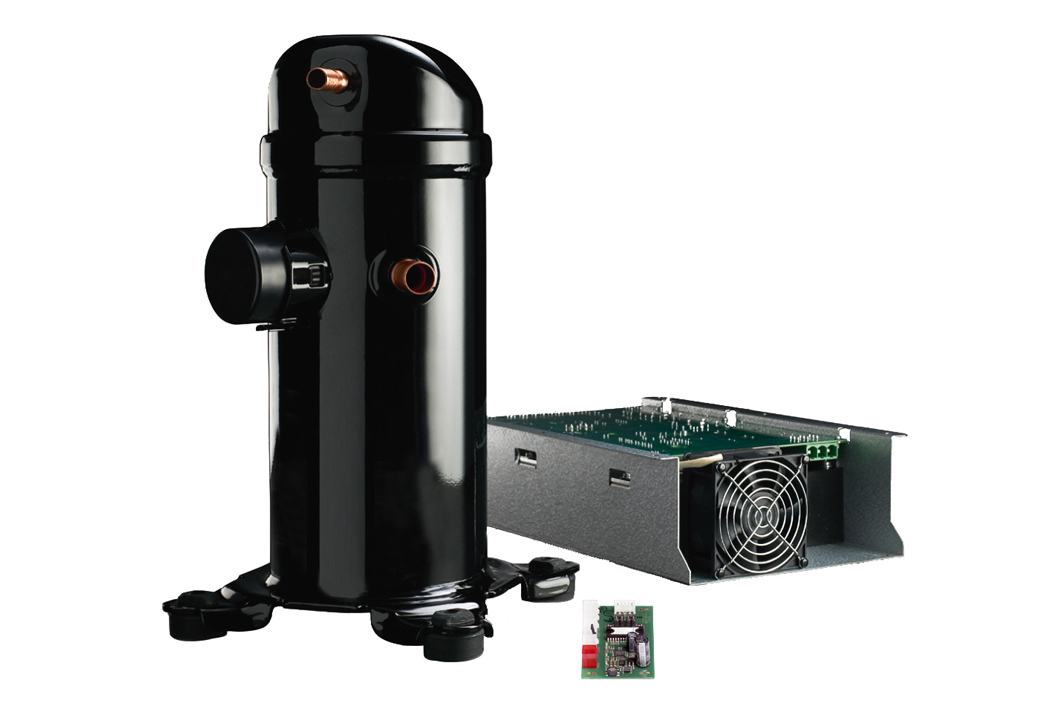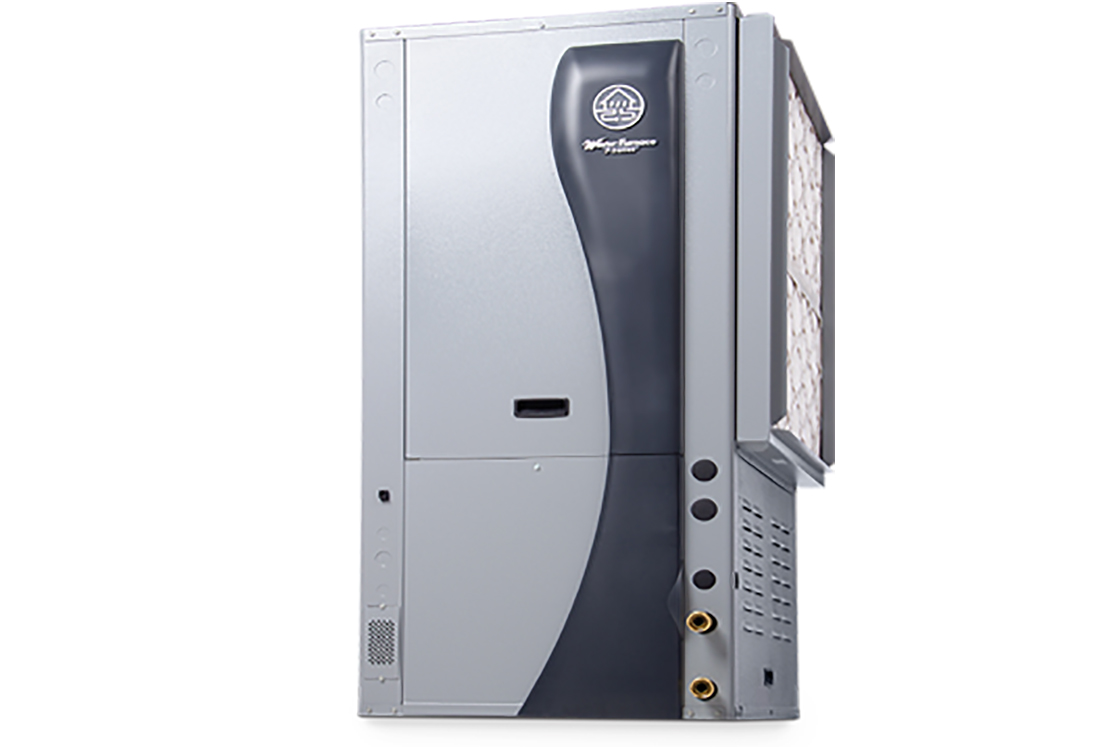53.2 energy efficiency ratio - A new residential geothermal heat pump can reach new levels of efficiency when variable speed technology is incorporated.
Because it draws heat from the ground or from water, a geothermal heat pump uses much less energy than a conventional heating system. And it is more efficient when it comes to cooling a building, saving energy and money. In fact, according to the International Ground Source Heat Pump Association (IGSHPA), a ground source heat pump is one of the most efficient residential heating and cooling systems available today, with heating efficiencies 50 to 70 percent higher than other heating systems and cooling efficiencies 20 to 40% higher than available air conditioners.
Despite these impressive statistics, manufacturers of geothermal heat pumps continue to push the envelope as they strive for even greater efficiencies. In fact, one split system residential geothermal heat pump — the WaterFurnace 7 Series™ — has hit 53.2 EER and 6.0 COP (ISO/AHRI 13256-1 GWHP), shaving 75 percent and 66 percent off cooling and heating costs, respectively. That represents a huge leap over any heat pump — conventional or geothermal — and sets a world efficiency record for the category by WaterFurnace, an Indiana-based geothermal heat pump manufacturer, thanks to a Danfoss variable speed compressor.
Reaching that Olympian level of efficiency was the result of four years of research and development. Early in the process, Bob Brown, vice president of engineering for WaterFurnace, learned that Danfoss had a high-efficiency solution worth considering.
"As efficient as geothermal heat pumps are, we wanted to push the envelope, knowing that more energy efficient components have become available," explains Brown. "We started looking at compressors, which are the heart of a heat pump. It compresses the refrigerant gas so it can expand and absorb heat."
Conventional heat pumps use a fixed-speed compressor that runs at full speed all the time. On cooler days when the system doesn't need full refrigerant flow — which is about 90 percent of the time — a fixed-speed compressor cycles on and off or uses some other energy-wasting technique to throttle back cooling capacity. Allowing a compressor to operate at a much lower capacity means the heat exchangers are relatively much larger, and, thus, provide much higher efficiency. In other words, a fixed-speed compressor is running less efficiently when it only operates at a fixed capacity.
"A better approach is to use a two-speed compressor," says Brown. "That's the type of compressor we use on our WaterFurnace Envision™ systems. With a two-speed compressor, you can shift to a lower speed to save energy when only a little cooling is required."
"But even better is a variable speed compressor. It can dramatically cut energy consumption, because it varies compressor capacity to match cooling or heating needs exactly, operating at a much higher efficiency most of the time on low compressor speeds."
To vary capacity, scroll compressors use one of several techniques. A scroll compressor operates by squeezing refrigerant between an orbiting spiral of metal and an identical stationary spiral. One technique slightly displaces the gas insertion point in the rotating scroll to limit refrigerant compression. This method varies refrigerant flow by changing the average time of compression, but not the actual RPM of the rotating scroll.
Danfoss, on the other hand, developed a scroll compressor that uses an external variable frequency drive (VFD) — also known as an inverter — to slow or speed up the AC motor that rotates the scroll. This method varies refrigerant flow by actually changing the RPM of the scroll. This technique and capability aided Brown's compressor selection — the Danfoss Performer® VRJ variable speed compressor.
"But even better is a variable speed compressor. It can dramatically cut energy consumption, because
it varies compressor capacity to match cooling or heating needs exactly, operating at a much higher efficiency most of the time on low compressor speeds."
– Bob Brown, vice president of engineering for WaterFurnace
The Danfoss Performer® VRJ variable speed compressor, a scroll compressor that uses an external variable frequency drive (VFD) — also known as an inverter — to slow or speed up the AC motor that rotates the scroll. This method varies refrigerant flow by actually changing the RPM of the scroll.

During the development period, Brown worked extensively with Danfoss and account manager Brian Kelley.
"You could buy a scroll compressor and an inverter off the shelf, but they won’t work as well together," says Kelley. "You need control logic and algorithms developed specifically for the system. Danfoss knows all about that, because we have spent years in our own extensive development process to get where we are today."
Kelley explains that Danfoss took the lead in introducing the first VFD for HVAC in 1968. "A VFD is critical to operating a variable speed compressor," he explains. "It reshapes the frequency of the current supplied to the AC motor to change speed, torque and overall performance. That's why a lot of intelligence is built into the inverter used in our Performer VRJ compressors."
The Danfoss variable frequency drive uses algorithms developed specifically for heating, ventilation and air conditioning (HVAC). Algorithms, which are programs that make decisions based on inputs and outputs, perform a number of jobs -- adjusting pressures and maintaining system stability as speed decreases and increases.
For the WaterFurnace 7 Series, a Danfoss VFD is paired inside the cabinet along with the Performer VRJ compressor.
"The Performer VRJ compressor is built in our Arkadelphia, Arkansas, plant," says Kelley. "As a variable speed scroll compressor, it operates through a range of high and low speeds, unlike one RPM for a fixed-speed scroll. Consequently, it can closely match the demands of the system to yield higher levels of energy efficiency."
Kelley explains that one challenge, however, is oil management. "As the scroll’s rotational speed changes, the amount of refrigerant — and oil — flowing through the compressor decreases. The VRJ compressor uses a patented oil injection system to ensure the scrolls and bearings are optimally lubricated at all compressor speeds.
"The VRJ compressor is also unique because it can run both slower and faster than what is standard. For example, it can turn down speed as low as 15 percent of its rated capacity and overspeed up to 117 percent from the nominal 3600 rpm. The overspeed capability means it can deliver more heat on colder days."
"The VRJ compressor allows us to do some unique things in equipment sizing," says WaterFurnace's Brown. "We can produce more heating capacity for a given home without increasing the length of buried loop. In technical language, it allows us to transfer heat from the earth loop — load it up between heating and cooling — more evenly. The result is higher heating capacity, which means lower operating costs and lower installed cost for the homeowner. This is a big advantage for areas north of the Mason Dixon Line and just south of the Great Lakes where we can take advantage of the loop balancing technique."
The ability to run the compressor, fans and pumps at slower than normal speeds brings another benefit — dehumidification. "The 7 Series has a special active dehumidification mode," explains Brown. "It turns the system into a whole-house dehumidifier, because the unit can dehumidify the home independently of whether it's heating or cooling. Most heat pumps will try to get moisture out of the air. But with our active dehumidification mode, the system can remove moisture without cooling or heating the home. Again, that means more comfort for less cost."
"Our 7 Series geothermal system is so clean and neat, it's unbelievable," Brown emphasizes. “People think it’s just too good to be true. The reality is, it is that good; it’s that efficient; it’s that simple; and we’re delivering that performance today."
– Bob Brown, vice president of engineering for WaterFurnace

"For us, improving efficiency is number one," says Brown. "Data shows that our systems only need to run at full speed 10 percent of the time. The rest of the time the compressor doesn’t have to run at full speed. By reducing compressor speed, we can reduce horsepower — and energy consumption in direct proportion. That is where a lot of our 7 Series electric savings come from."
But to take full advantage of a variable speed compressor's potential, the entire system also has to become more intelligent. According to Brown, "All the things you're used to using — like thermostats — will not work with variable speed. A conventional thermostat is accustomed to just turning the equipment on or off. It doesn't tell the equipment that I only need 40 percent [for example]. The controls must have the sophistication to communicate with a smart compressor control to know exact room temperatures, where the temperature is heading, what percentage of capacity is required and how long to operate. That is why we developed the Aurora control system, which features communications, color touchscreen thermostats and color touchscreen integrated zoning."
Along with the Aurora controls, other components must handle the unique demands of variable speed operation. That’s why Brown also uses a Danfoss electronic expansion valve (EEV) to ensure the compressor gets the right amount of refrigerant as compressor speeds change.
"Electric companies appreciate how well we can manage these systems, because they aren't running full speed all day, all the time. And they don't pull a lot of electricity when they start up. Of course, homeowners also like it because it's incredibly quiet and delivers amazing energy savings. On an open loop system with partial load, we get up to 53.2 EER and 6.0 COP. A COP that high means the homeowner can eliminate the use of auxiliary heat, even in far northern climates."
"Our 7 Series geothermal system is so clean and neat, it's unbelievable," Brown emphasizes. "People think it’s just too good to be true. The reality is, it is that good; it's that efficient; it's that simple; and we’re delivering that performance today."
"We set a new record. That's because we got started on the right track with Danfoss."
